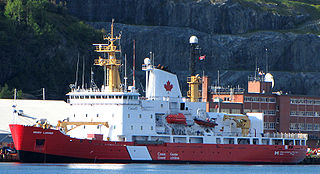
CCGS Henry Larsen is a Canadian Coast Guard Improved Pierre Radisson-class icebreaker serving in the Newfoundland and Labrador region and based in St John's, Newfoundland and Labrador. Entering service in 1988, Henry Larsen is the fourth ship and of an improved design over the rest of the ships in her class. The ship operates in the Arctic Ocean during summer months.

CCGS Amundsen is a Pierre Radisson-class icebreaker and Arctic research vessel operated by the Canadian Coast Guard. The vessel entered service in 1979 as Franklin and was renamed Sir John Franklin in 1980 and served as such until 1996. Declared surplus, the vessel was used as an accommodation ship in Labrador in 1996 and placed in reserve in 2000. In 2003, the ship was reactivated and underwent conversion to an Arctic research vessel. The ship recommissioned as Amundsen.

CCGS Sir William Alexander is a Martha L. Black-class light icebreaker. Entering service in 1987, the vessel is currently assigned to CCG Maritimes Region and is homeported at CCG Base Dartmouth, in Dartmouth, Nova Scotia. The vessel is named after Scottish explorer Sir William Alexander, 1st Earl of Stirling, who was an early colonizer of Nova Scotia.
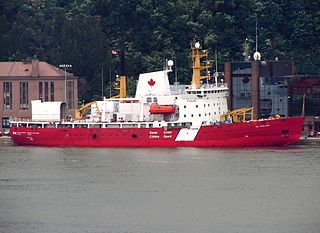
CCGS Des Groseilliers is a Pierre Radisson-class icebreaker in the Canadian Coast Guard. The vessel is named after Médard Chouart des Groseilliers (1618–1669) a close associate of Pierre-Esprit Radisson in explorations west of the Great Lakes and the founding of the British Hudson's Bay Company. The ship entered service in 1982. The vessel has participated in a number of research voyages, including Ice Station SHEBA. As part of the Surface Heat Budget of the Arctic Ocean experiment conducted in the Arctic Ocean from October 1997 to October 1998 to provide polar input to global climate models, Des Groseilliers was allowed to be frozen into the ice for the Arctic winter, to serve as a base for scientific researchers.
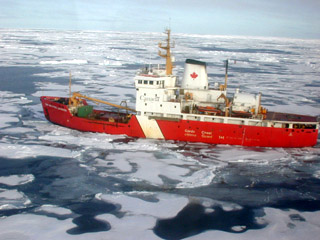
CCGS Sir Wilfrid Laurier is a Martha L. Black-class light icebreaker and major navaids tender of the Canadian Coast Guard. Built in 1986 by Canadian Shipbuilding at Collingwood, Ontario, Canada, she was the last ship constructed there. The ship has been based out of Victoria, British Columbia.

Almirante Óscar Viel was an icebreaker in service with the Chilean Navy in 1995–2019. Originally built for the Canadian Coast Guard as CCGS Norman McLeod Rogers, named for former Canadian Member of Parliament and cabinet minister Norman McLeod Rogers (1894–1940), the vessel was acquired by Chile in 1994 and renamed after Counter Admiral Óscar Viel y Toro (1837–1892), the commander of the Chilean naval forces from 1881 to 1883 and 1891.

CCGS Simcoe was a Canadian Coast Guard buoy tender and light icebreaker. The second vessel of the name in Canadian government service, Simcoe was in service from 1962 to 2007 based out of the Coast Guard base at Prescott, Ontario working the Great Lakes and Saint Lawrence Seaway. In 2008 the ship was sold to commercial interests.

CCGS D'Iberville was a Canadian Coast Guard icebreaker that was in service from 1952 to 1983 and was Canada's first modern icebreaker. The ship commissioned as CGS D'Iberville for the Department of Transport's Marine Service, using the prefix "Canadian Government Ship", D'Iberville was transferred into the newly-created Canadian Coast Guard in 1962. When launched, she was the largest icebreaker in use by Canada post-World War II until CCGS John A. Macdonald was put in service. In 1984, the icebreaker was renamed Phillip O'Hara before returning to her old name in 1988. In 1989 the vessel was sold for scrap and broken up at Kaohsiung, Taiwan.
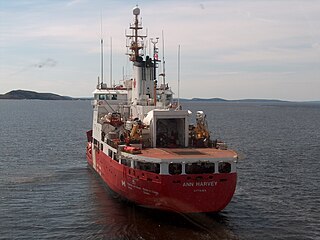
CCGS Ann Harvey is a Canadian Coast Guard buoy tender and SAR vessel with light icebreaker duties. She was constructed in 1987 by Halifax Dartmouth Industries, in Halifax, Nova Scotia. The vessel was named after Ann Harvey, the daughter of a local Newfoundland fisherman who helped rescue 185 people during her lifetime. Ann Harvey's home port is St. John's, Newfoundland and Labrador and is stationed there with other Coast Guard ships.

CCGS Sipu Muin is a Canadian Coast Guard Type 400 AP1-88 air cushion vehicle (ACV) or hovercraft based at CCG Hovercraft Base Trois-Rivières in Trois-Rivières, Quebec. The vessel was launched and completed in 1998 and entered service the same year. Sipu Main is predominantly used for icebreaking, search and rescue, and for servicing navigational aids in the Lower Saint Lawrence River and St. Lawrence Seaway.

CCGS Pierre Radisson is the lead ship of her class of icebreakers. Constructed and operated by the Canadian Coast Guard, the vessel is based at Quebec City on the Saint Lawrence River. The ship was constructed in British Columbia in the 1970s and has been in service ever since. The vessel is named for Pierre-Esprit Radisson, a 17th-century French fur trader and explorer.
CCGS Earl Grey is a Samuel Risley-class light icebreaker and buoy tender in the Canadian Coast Guard. Constructed in 1986, the vessel serves a variety of roles, including light ice-breaking and buoy tending, as well as being strengthened for navigation in ice to perform tasking along the shores off the Atlantic coast of Canada. Like her sister ship, CCGS Samuel Risley, she carries a large and powerful crane on her long low afterdeck for manipulating buoys. Earl Grey is the second icebreaker in Canadian service to carry the name.

CCGS George R. Pearkes is a Martha L. Black-class light icebreaker and buoy support vessel in the Canadian Coast Guard. Named for Victoria Cross-winner George Pearkes, the ship entered service in 1986. Initially assigned to Pacific region, the vessel transferred to the Quebec region. George R. Pearkes was assigned to her current deployment, the Newfoundland and Labrador region in 2004.
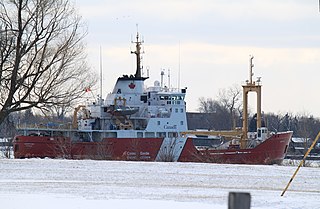
Canadian Coast Guard Ship Griffon is a Canadian Coast Guard (CCG) high endurance multi-tasked vessel and light icebreaker stationed in Prescott, Ontario, Canada. Completed in 1970, Griffon provides icebreaking services along eastern Lake Ontario and upriver along the Saint Lawrence River to Montreal.

CCGS Sir Humphrey Gilbert was a Canadian Coast Guard light icebreaker and buoy tender and now a privately owned Arctic icebreaker Polar Prince. The ship entered service with the Department of Transport Marine Service in 1959 and transferred to the newly created Canadian Coast Guard in 1962, active until 1986. The icebreaker was sold to private interests in Newfoundland and the ship sat idle after 2001 until resold in 2009 to GTX Technology Canada Limited and renamed Polar Prince. Rebuilt, the icebreaker is now plying the waters of the Arctic Ocean. In 2017, the vessel was temporarily rechristened Canada C3 and used for a high-profile voyage around Canada's three maritime coasts as part of the nation's 150th anniversary.

CCGS Kopit Hopson 1752, formerly CCGS Edward Cornwallis, is a Martha L. Black-class icebreaker of the Canadian Coast Guard. She serves as a light Icebreaker and buoy tender on the East Coast of Canada. Entering service in 1986, the vessel is homeported at Dartmouth, Nova Scotia. The vessel was originally named after Lieutenant General Edward Cornwallis, a British Army officer and founding governor of Halifax, Nova Scotia. Due to the controversial history of the vessel's initial namesake, the ship was renamed in consultation with indigenous peoples, to commemorate Jean-Baptiste Cope under his Mi'kmaq name, British Governor Peregrine Hopson, and the year of the peace and friendship treaty created by former Governor Edward Cornwallis.
CCGS J.E. Bernier was a Canadian Coast Guard medium Arctic icebreaker with a steel hull. The vessel was in service from 1967 to 2006. The ship was initially based at Quebec City but finished her career at St. John's. The ship was named for Joseph-Elzéar Bernier, captain of CGS Arctic which explored and monitored the eastern Arctic for the Government of Canada in the early 20th century. The vessel was sold in 2006 to private interests.

The Martha L. Black-class icebreakers are a class of six light icebreaker and buoy tenders constructed for and operated by the Canadian Coast Guard. Built in the 1980s, the class operates on both coasts of Canada and have been used for operations in the Arctic region, including the search for the ships of Franklin's lost expedition. They are rated as "high endurance multi-tasked vessels" under Canadian Coast Guard naming rules.

The Samuel Risley-class icebreakers are a class of two icebreakers and buoy tenders constructed for and operated by the Canadian Coast Guard. The two ships are based on offshore supply tugboat design and entered service in the 1980s. Samuel Risley is deployed to the Central Region, operating mainly on the Great Lakes of North America, while Earl Grey is posted to Atlantic Canada, working off the east coast of Canada.

The Pierre Radisson-class icebreakers, also known as R-class icebreakers, are a class of four icebreakers constructed for and operated by the Canadian Coast Guard. The Canadian Coast Guard designates the four ships in the class as medium icebreakers. Built in two phases, the first three ships, Pierre Radisson, Franklin and Des Groseilliers, were built to a common design. The fourth, Henry Larsen was built to a modified design and is considered a subclass, the Improved R-class icebreaker. Franklin was later renamed Sir John Franklin before undergoing a re-design for use primarily as an Arctic research vessel. Upon the vessel's return to service, the ship was once again renamed Amundsen. All the vessels are named for people who sailed through Canada's northern waters. The class operates in the Arctic Ocean in the summer, patrolling, icebreaking and research missions.




















